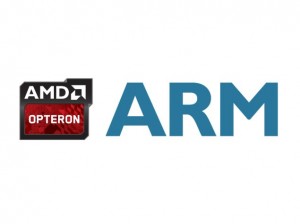 ARM, the architecture that powers nearly every tablet and smartphone on the market today, will soon debut in high-performance data centres. AMD has unveiled its new Opteron A1100 processor for high-density server applications, which uses ARM’s recently developed 64-bit ARMv8 instruction set. This will be the chipmaker’s first non-X86 server CPU, and represents a significant shift in direction for the industry as a whole. Servers based on the new chip will begin shipping in the second half of 2014. There is no indication of the cost of the chips or servers based on them yet.
ARM, the architecture that powers nearly every tablet and smartphone on the market today, will soon debut in high-performance data centres. AMD has unveiled its new Opteron A1100 processor for high-density server applications, which uses ARM’s recently developed 64-bit ARMv8 instruction set. This will be the chipmaker’s first non-X86 server CPU, and represents a significant shift in direction for the industry as a whole. Servers based on the new chip will begin shipping in the second half of 2014. There is no indication of the cost of the chips or servers based on them yet.
AMD estimates that 25 percent of the server market could migrate to ARM-based platforms in the next five years, and is thus trying to spur a mass shift to smaller, more scalable, lower cost server products. With certain workloads, the company is boasting 2-4x improvements in compute power compared to its own X86-based server processors with similar power consumption characteristics.
AMD had licensed ARM’s instruction set in late 2012, and had targeted a 2014 release for its first ARM-based products. The company has so far designed processors around the X86 architecture, but in recent years has struggled to compete with Intel, in terms of both raw performance and power efficiency. Sensing a shift towards cloud-driven server workloads and data centre environments that prioritise extreme scalability, low power consumption, low cooling requirements and low total cost of ownership, AMD also acquired micro-server specialist SeaMicro the same year.
In a press statement announcing the launch, Suresh Gopalakrishnan, corporate vice president and general manager of the AMD server business unit described the new Opteron A1100 as “the ideal complement to our established AMD Opteron x86 server processors”, underscoring the fact that AMD has no plans to abandon the X86 server market. It is not clear whether the company also intends to develop ARM-based processors for consumer applications such as tablets and smartphones, a market that graphics competitor Nvidia also plays in.
The Opteron A1100, codenamed “Seattle”, will have four or eight ARM Cortex A57 cores running at around 2GHz, up to 4MB of L2 cache and 8MB of L3 cache, and support for dual-channel DDR3 and DDR4 ECC RAM. Official documents make no mention of a graphics component, but there will be significant on-die communications capabilities including dual Gigabit Ethernet lanes, eight lanes of third-generation PCIe and eight 6Mbps SATA lanes. AMD has also integrated additional on-die logic for security, cryptography and data compression.
In March, AMD will begin offering its partners a standard micro-ATX development kit that will work with industry standard power supplies, rack mount enclosures, RAM, PCIe cards and SATA storage devices. Developers will also have access to a Fedora-based Linux operating environment that includes Apache, MySQL, PHP and Java.
ARM Holdings licences its CPU architecture to companies such as Qualcomm, Texas Instruments, Apple, Samsung and many others, which manufacture a variety of CPUs for different purposes. The architecture has been especially successful in applications that demand low power consumption, including small portable gadgets, cars, appliances and industrial machinery.
Source-NDTV








